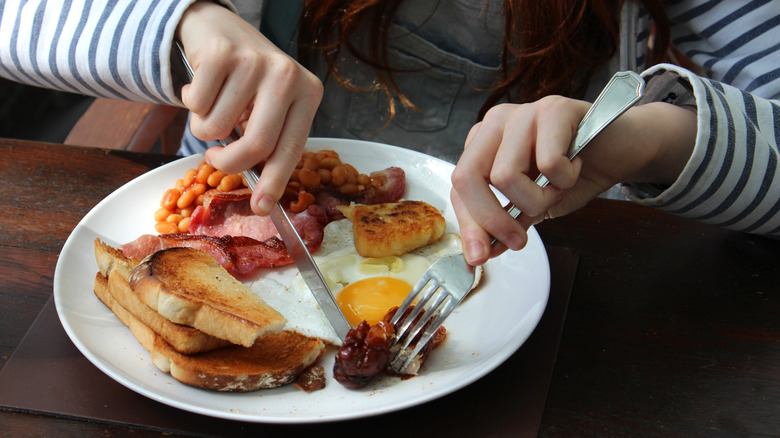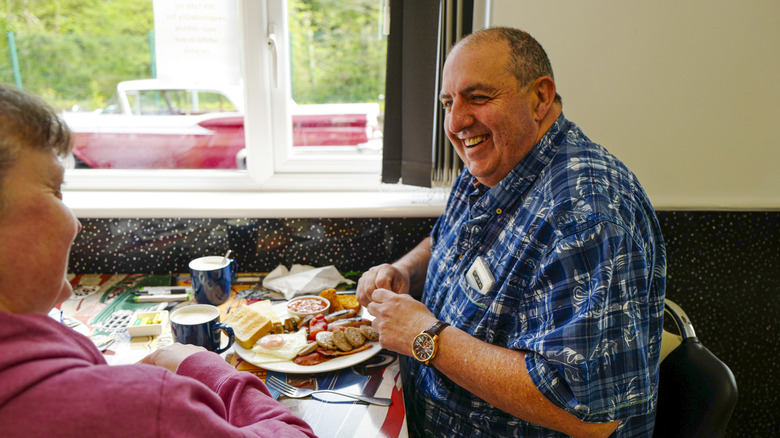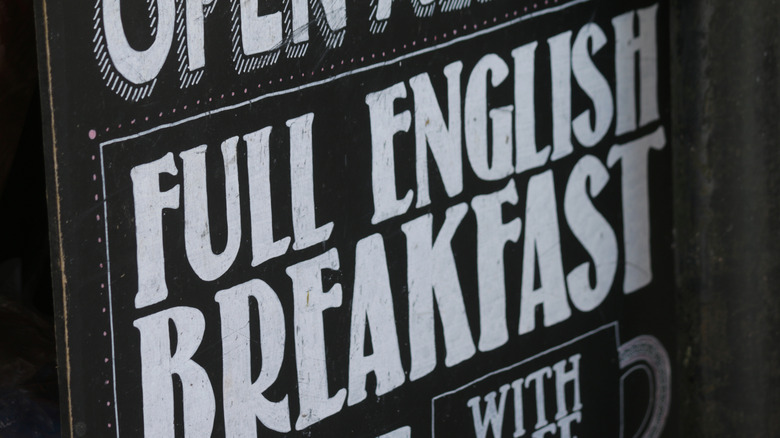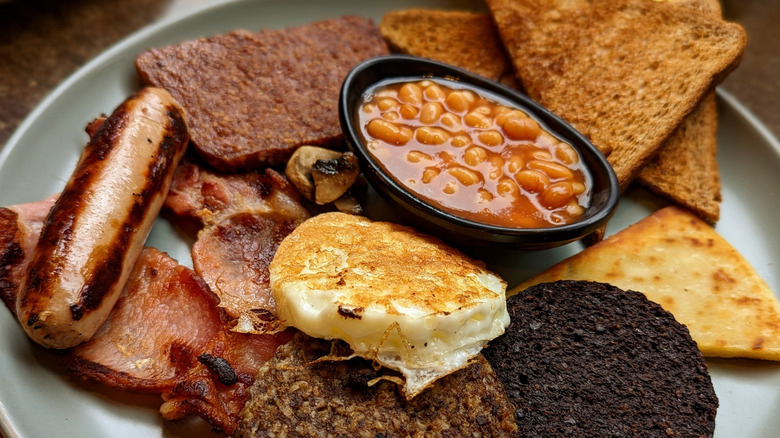The European Country Rick Steves Has Referred To As 'Fried-Breakfast Land'
British food sometimes takes a bit of a bashing, but when the classics are done right they are a thing of simple beauty. Just take the traditional national dish of fish and chips. While the good old-fashioned chip shop is on the wane , an astonishing 87% of people in a 2024 YouGov poll ranked the combo as Britain's most popular meal. A little further down the chart is another simple but delicious dish: The full English breakfast, a.k.a. the fry-up. Even TV host, author, and travel expert Rick Steves is a fan. While he has jokingly dubbed the British Isles (per his website) "fried-breakfast land" and referred to the hearty dish as "heart attack on a plate," he admits that a trip to the U.K. just isn't the same without one.
The fry-up is almost universally popular across Britain, served everywhere from greasy spoon cafes to the Ritz. Brits love their fry-ups so much that many pubs and restaurants will offer an all-day option, and it isn't uncommon to see people eating one for dinner with a pint. It isn't just a sit-down meal, either. Britain is a nation of sandwich lovers, and most supermarket chains sell all-day breakfast sandwiches in their chiller cabinet section. To the uninitiated, the full English breakfast may seem like a massive amount of food to consume in the morning, especially compared to lighter breakfast fare on the Continent. But what is the perfect way to eat it, and when did the British love affair with the fry-up begin?
The perfect full English breakfast
As Rick Steves notes on his website, the basic components of a full English breakfast are simple: bacon, egg, sausage, tomatoes, mushrooms, and toast. Like fish and chips, however, your enjoyment will often come down to the quality of ingredients, and there are a range of extras that cause much debate among Brits. Should the egg be fried, scrambled, or poached? How does anyone stomach black pudding? Do chips belong in a fry-up? Then there is the age-old indicator of the invisible north-south divide: Do you go for ketchup or brown sauce?
One thing most Brits agree about is that the chief ingredient should be quality cuts of back (Canadian-style) bacon, sizzled until the fat goes a little crispy. Cheap processed sausages are largely a thing of the past, with pretty much everywhere nowadays serving chunky well-seasoned bangers. Scrambled eggs common but sunny side up fried eggs are generally considered the best, cooked until the yolk is still a little runny.
Tomatoes and mushrooms (grilled or fried) rarely cause much controversy. Baked beans are a popular feature, with Heinz being the preferred brand. For many people, hash browns have quietly become a key addition, with some even calling them the MVP of the fry-up. Lastly, toast is integral. You don't need anything fancy, just decent sliced white bread will do the trick nicely. It's perfect for mopping up the mixture of grease, egg yolk, and bean juice at the end of the meal.
How Britain fell in love with the fry-up
The good old fry-up pre-dates some other British favorites by quite a few centuries. The first fish and chip shop (a "chippy") was thought to be opened by Jewish immigrants in the 19th century, and the invention of the sandwich is often attributed to the 4th Earl of Sandwich in 1762. The general concept of an "English" breakfast, as opposed to just breakfast, may go back as early as the Norman invasion of 1066.
The hearty plates we know today, however, most likely originated with the landed gentry from the 14th and 15th centuries, who would put on a massive spread to impress their chums before going out hunting. Another 400 years or so would pass before the full English breakfast went from a luxury of the rich to something more commonly associated with the working and middle classes.
In the early 20th century, the meal took on a form we would recognize today, coalescing around bacon, eggs, sausages, butter beans, tomato, and other ingredients that have largely fallen by the wayside like bubble and squeak (mashed potatoes and cabbage), smoked kippers, and haddock. Its popularity grew to the extent that by 1950 around half the population of Britain started their day with a full cooked breakfast, cementing its status as a true working-class tradition. Now it's not just something you get in the British Isles — resorts around the world that cater to British tourists will usually offer a fry-up option.
Regional variations of the fry-up
For the sake of convenience, we have so far referred to the fry-up as a full English breakfast. However, as Rick Steves points out, variations are common in all parts of the British Isles and the Scottish version is one of his favorite things about staying at a bed and breakfast in Scotland. The U.K. is made up of four nations (England, Wales, Scotland, and Northern Ireland) and each has its own slant on the classic "English" format — nobody ever calls it a full British breakfast.
Each region sticks to the basics like bacon, sausages, eggs, and tomatoes but also adds their own distinctive components. A full Scottish breakfast will often add tattie (potato) scones, lightly spiced square sausage, and haggis, an offbeat European delicacy traditionally made from sheep's offal and other ingredients stuffed inside a casing made from the animal's stomach. The Scots are also lovers of black pudding (pork blood sausage) and/or the less common white pudding (oatmeal sausage).
Over in Wales, the full Welsh breakfast often features laverbread. Rather than an actual bread, it is a mushy side dish made from seaweed. Also from the sea are cockles, small shellfish that reflect the nation's fishing tradition. Local Welsh sausage may also incorporate leeks, the national vegetable. Across the water in Northern Ireland and the Republic of Ireland, the full Irish adds soda bread, made with baking soda rather than yeast, and potato farls. The latter is made from mashed potatoes and are often preferred to hash browns.



